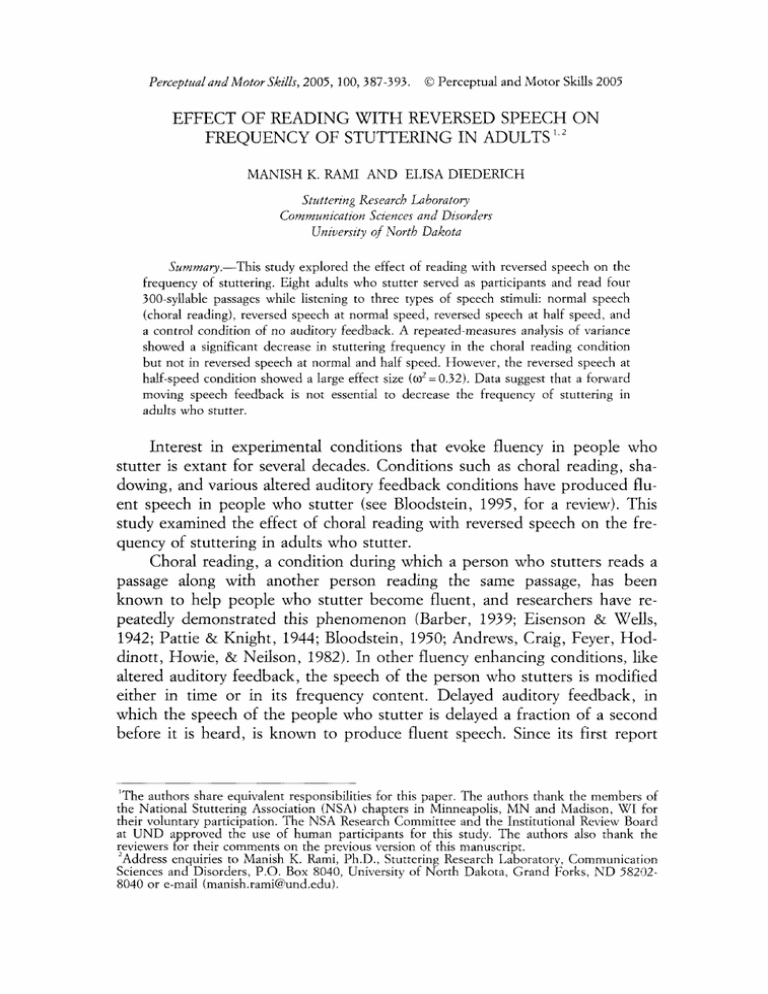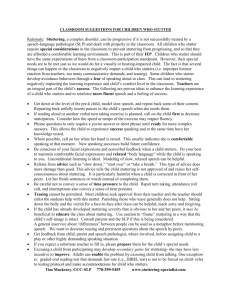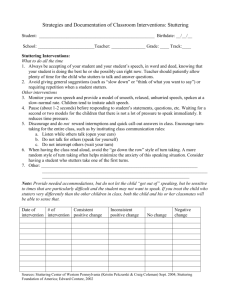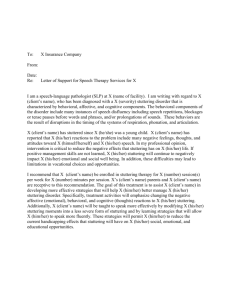',' OF EFFECT READING WITH REVERSED SPEECH O N
advertisement

Perceptualand Motor Skills, 2005, 100,387-393. O Perceptual and Motor Skills 2005 EFFECT OF READING WITH REVERSED SPEECH O N FREQUENCY O F STUTTERING I N ADULTS ',' MANISH K. RAM1 AND ELISA DIEDERICH Stuttering Research Laborato y Communication Sciences and Disorders University of North Dakota Summary.-This study explored the effect of reading with reversed speech on the frequency of stuttering. Eight adults who stutter served as participants and read four 300-syllable passages while listening to three types of speech stimuli: normal speech (choral reading), reversed speech at normal speed, reversed speech at half speed, and a control condition of no auditory feedback. A repeated-measures analysis of variance showed a significant decrease in stuttering frequency in the choral reading condition but not in reversed speech at normal and half speed. However, the reversed speech at half-speed condition showed a large effect size (02= 0.32). Data suggest that a forward moving speech feedback is not essential to decrease the frequency of stuttering in adults who stutter. Interest in experimental conditions that evoke fluency in people who stutter is extant for several decades. Conditions such as choral reading, shadowing, and various altered auditory feedback conditions have produced fluent speech in people who stutter (see Bloodstein, 1995, for a review). This study examined the effect of choral reading with reversed speech on the frequency of stuttering in adults who stutter. Choral reading, a condition during which a person who stutters reads a passage along with another person reading the same passage, has been known to help people who stutter become fluent, and researchers have repeatedly demonstrated this phenomenon (Barber, 1939; Eisenson & Wells, 1942; Pattie & Knight, 1944; Bloodstein, 1950; Andrews, Craig, Feyer, Hoddinott, Howie, & Neilson, 1982). In other fluency enhancing conditions, like altered auditory feedback, the speech of the person who stutters is modified either in time or in its frequency content. Delayed auditory feedback, in which the speech of the people who stutter is delayed a fraction of a second before it is heard, is known to produce fluent speech. Since its first report 'The authors share equivalent responsibilities for this paper. The authors thank the members of the National Stuttering Association (NSA) cha ters in Minneapolis, MN and Madison, WI for their voluntary participation. The NSA ResearcR Committee and the Institutional Review Board at UND a proved the use of human participants for this study. The authors also thank the 5eviewers E r their comments on the previous version of this manuscript. Address enquiries to Manish K. Rami, Ph.D., Stuttering Research Laboratory, Communication Sciences and Disorders, P.O. Box 8040, University of North Dakota, Grand Forks, ND 582028040 or e-mail (manish.rami@und.edu). 388 M. K. RAM1 & E.DIEDERICH (Lee, 19501, this effect has been replicated in numerous studies (Webster, Schumacher, & Lubker, 1970; Martin & Haroldson, 1979; Andrews, Howie, Dozsa, & Guitar, 1982). Howell, El-Yaniv, and Powell (1987) introduced the concept of frequency-altered feedback. These authors shifted the frequency of the participants' voices down one octave, and the fluency-enhancing effects were noted. Since then, numerous studies have yielded similar effects on the speech of people who stutter (Kalinowski, Armson, Roland-Mieszkowski, Stuart, & Gracco, 1993; Hargrave, Kalinowski, Stuart, Armson, & Jones, 1994; Stuart, Kalinowski, Armson, Stenstrom, & Jones, 1996). All of these conditions, choral reading, delayed auditory feedback, and frequency-altered feedback, invariably have forward moving speech as a feedback signal and are sufficient to decrease the amount of stuttering. These conditions change the speech signal heard, but the semantic cues in the speech remain intact. It remains to be examined whether forward flowing speech with the semantic cues is necessary to produce a decrease in the amount of stuttering. The current study was designed to investigate the effects of reading with reversed speech on the frequency of stuttering in adults. Reversed speech stimuli would provide no semantic cues and, if they were necessary to aid the person who stutters in producing fluent speech, they would fail. This study examined whether reading with reversed speech at normal speed and at half speed decreased the frequency of stuttering. The reversed speech at half speed condition was used since it is a widely held notion supported by Max and Caruso (1998) that slow speech makes people who stutter fluent. It was hypothesized that both reversed speech conditions at normal and half speed would decrease the frequency of stuttering. A choral reading condition was included to replicate the choral effect. Particzpants Eight adults who stutter (5 men, 3 women), each diagnosed to be a person who stutters by a speech-language pathologist, served as participants. Participants were recruited by contacting chapters of the National Stuttering Association in the states of Minnesota and Wisconsin. Their ages ranged from 19 to 54 years. Case history and a short, informal conversation were used to screen participants for speech, language, or neurological disorders other than stuttering. They had at least high school education or its equivalent and produced at least 2 % disfluencies in reading a 300-syllable passage. The Stuttering Severity Index-3 ratings (&ley, 1994) ranged from mild (3/8), to moderate (4/8), and severe (1/8). The amount of disfluencies ranged from 2 % to 17% (M= 7.5 %, SD = 5.8). The participants' hearing was screened to be within normal limits (American Speech-Language-Hearing Association, 1990). REVERSED SPEECH AND STUTTERING 389 Stimuli A normal speaking male (age 28 years) volunteer read three 300-syllable passages from two junior high texts (Taylor, 1985; Sims, 1987). All the signals were sampled at 44100 Hz in a sound-treated booth (Ray Proof Sound Shield Model 803), on a Digital Audio Tape (DAT) recorder (Sony Model ZA5ES) via a microphone (Shure Model SM48) placed approximately 30 cm from the lips with an orientation of 0" azimuth and -30" altitude. One sample was transferred on a personal computer (Apple model Power Macintosh 9600/300) using a portable DAT recorder (Sony Model TCD 8) and was used for the Choral reading condition. The two others were routed from the portable DAT into a commercially available sound and signal analysis program (Macromedia Inc. Model Sound Edit 16, ver. 2.0.7) running on a personal computer (Apple model Power Macintosh 9600/300) for further processing. The backwards effect was applied to one of the signals to produce the reversed speech at normal speed stimulus. The last stimulus was reversed before applying the tempo effect to produce the reversed speech with a half speed stimulus. These signals were normalized in intensity and recorded in Audio Interchange File Format (AIFF) on an audio compact disk (CD) using a commercial software (Adaptec, Model Toast Ver. 3.5.6 PPC) and a CD writer (La Cie Model CRW 4416s) for use as stimuli in this experiment. Apparatus Each participant was comfortably seated in front of a video camera (Sony Model CCD-TRV 43) in a quiet room setting. The stimuli (CD) was played on a CD player (Tascam Model CD-150)) and the participant heard the stimuli via earphones (Radioshack, Model Extreme) at a comfortable listening level above 65 dB SPL. The audio speech samples from the participant were recorded with a wireless lapel microphone (Shure Model UC14/ 85-UB) placed approximately 14 cm from the lips. The microphone output was fed into a portable DAT recorder (Tascam Model DA-PI) to make an audio recording. A camera (Sony Model CCD-TRV 43) was used to make an audiovisual recording. Procedure The experimenter set up individual meetings with participants. Before the experiment began, the experimenter read and explained the consent form, and signed consents were obtained from participants. Questions or concerns were addressed at that time. The participants were then led into a quiet, unoccupied room where equipment was set up. Each participant was placed approximately 3 m from the video camera. The room was free from other distractions. The passages used contained approximately 300 syllables and were from 390 M. K. RAM1 & E. DIEDERICH Taylor (1985) or Sims (1987). Participants were given the passages one at a time and were instructed to read aloud as soon as they heard the stimuli and continue reading until they finished the passage. This procedure was repeated under each of the four conditions: no auditory feedback, choral reading, reading with reversed speech played at normal speed, and reading with reversed speech played at half speed. It should be noted that truly synchronous choral speech might result only after a great amount of rehearsal. During the experimental conditions, the participants spoke at their own rate while continuing to listen to asynchronous stimuli signals. A 4 x 4 digram balanced Latin square was used to set the order of presenting the stimuli to each participant. To ensure there were no carryover effects, the participants were engaged in a 2-min. conversation between conditions, and they then read aloud and backwards an approximately 250-syllable passage. The frequency of stuttering was measured for all conditions using the audio-video recordings. Stuttering episodes, defined as part- and whole-word repetitions, part-word prolongations, and inaudible postural fixations, were counted from the first 300 syllables of each passage. Interjudge syllable-bysyllable reliability, as indexed by Cohen Kappa (Cohen, 1960)) was obtained by having a second-year graduate student in speech-language pathology reanalyze 20 % of the data. Agreement was .75. Intrajudge syllable-by-syllable reliability, as indexed by Cohen Kappa, was also measured (.90). Kappa values of .75 or higher indicate excellent agreement (Fleiss, 1981). RESULTS The frequency of stuttering during the reading of four different 300-syllable passages under each of the four conditions were the raw data. The mean number of syllables stuttered during each condition and the standard deviation for each participant were calculated; see Table 1. TABLE 1 MEANS AND STANDARD DEVIATIONS OF NUMBER OF STUTTERED SYLLABLES DURING A 300-SYLLABLE READING PASSAGE BY CONDITION (N= 8) Experimental Condition M SD No auditory feedback Choral reading Reversed normal-speed Reversed half-speed 11.6 4.3 8.4 6.0 9.8 1.5 5.7 4.8 A repeated-measures analysis of variance indicated that the experimental conditions significantly changed the frequency of stuttering (F,,2,= 4.4 1, Greenhouse-Geisser p = .04, power = 3 ) . Tests of simple within-subject contrasts were conducted to identify the source of the variance. This test yielded a statistically significant difference between the no auditory feedback and REVERSED SPEECH AND STUTTERING 391 the choral reading condition (F,,, = 5.73, p = .05, power = 3 4 , o2= 0.37). There were no significant differences between conditions of no auditory feedback and the reversed speech at normal speed (F,,7= 1.96, p = 2 0 , power = .23, w2= . I ) and of no auditory feedback and reversed speech at half speed conditions (F,,, = 4.79, p = .07, power = .47, w2= 3 2 ) . The effect size is considered small at wZ = .Ol , moderate at .06, and large at .I5 (Keppel, 1991). Since the effect sizes of the last two comparisons are moderately large to large, individual data were inspected (see Fig. 1). Participant FIG. 1. A bar ra h showing frequencies of stuttering/300 syllables for each participant (NAF: No auditory E J b a c k , CR: Choral reading, RN:Reversed speech at normal speed, RH: Reversed speech at half speed) It was noted that under the reversed speech at normal speed condition, 37.5% (3/8) of the participants showed an improvement of 15-67%, 50% (4/8) of the participants showed no increase in fluency in their speech, and 12.5% (1/8) of the participants showed an increase (33%) in stuttering frequency, while in the reversed speech at half speed condition, 62.5% (5/8) of the participants showed 52-100% reduction in stuttering, 25% (2/8) of the participants showed 16-26% reduction in stuttering frequency, and 12.5% (1/8) of participants showed an increase (16%) in stuttering. At least three participants orally reported feeling more relaxed under the reversed speech at half speed condition. 392 M. K. RAM1 & E. DIEDERICH DISCUSSION The choral reading condition in this study produced a statistically significant decrease in the frequency of stuttering, and a large effect size as indexed by partial omega squared (Keppel, 1991). This finding concurs with and supports the literature (Johnson & Rosen, 1937; Barber, 1939; Eisenson & Wells, 1942; Pattie & Knight, 1944; Andrews, et al., 1982; Bloodstein, 1995). The reversed speech at normal speed condition did not significantly decrease the frequency of stuttering, so data do not support the hypothesis that reading with reversed speech played at normal speed decreases the frequency of stuttering. The reversed speech at half speed condition produced no statistical significance but it did produce a large effect size. This was evident as 87.5% (7/8) of the participants showed at least some decrease in the frequency of stuttering under the reversed speech at half speed condition. These results point to the possibility that a forward moving speech signal does not seem necessary to induce fluency and neither do the semantic cues. Pattie and Knight (1944) proposed that the fluent reader acts like a pace-setting mechanism for the people who stutter. When they read in unison with another person, it imposes a steady rhythm of speech that helps them talk more fluently. These data partially support this proposal. It is suggested that the stimulus, reversed speech at half speed, possibly contained intonation patterns similar to everyday speech, which could have acted as a pace-setter for the participants. An alternative hypothesis by Cherry (1953), Andrews, et al. (1982), and Healey and Howe (1987) is that the reduction in the frequency of stuttering is caused by a reduction in the requirements for language formation. The present study does not support this hypothesis because the reversed speech at half speed did produce a positive change in 87.5% (7/8) of the participants, and the feedback it provided was at least semantically meaningless, requiring participants to form their own meaningful language. Another hypothesis to explain these effects is the distraction explanation (Barber, 1939; Bloodstein, 1995). Distraction is removing the attention of the person who stutters from the act of speaking. If the experimental conditions were distracting the participants, then all the conditions should have produced fluent speech, which was not the case, and hence the distraction explanation is not tenable. In this study, the stimulus of reversed speech at normal speed did not produce statistically significant results while the stimulus of reversed speech at half speed produced some positive but no statistically significant result. This could reflect the low statistical power (.23) in this study. In addition, since a majority of the participants (7/8) showed mild or moderate severity of stuttering, the presence of floor effects cannot be ruled out. Researchers should avoid such limitations in further study of this phenomenon. REVERSED SPEECH AND STUTTERING 3 93 REFERENCES (ASHA). (1990) Guidelines for screening for AMERICAN SPEECH-LANGUAGE-HEARING ASSOCIATION hearing impairment and middle-ear disorders. American Speech-Language-Hearing Association, 32, 17-24. ANDREWS, G., CRAIG,A., FEYER,A. M., HODDINOTT, S., HOWIE,I?, &NEILSON, M. (1983) Stuttering: a review of research findings and theories circa 1982. Journal of Speech and Hearing Disorders, 48, 226-245. ANDREWS, G., HOWIE,I?, DOZSA,M., &GUITAR, B. (1982) Stutterin : speech pattern characteristics under fluency-inducing conditions. Journal of Speech anfHearing Research, 25, 208216. BARBER, V. (1939) Studies in the psychology of stuttering: XV. Chorus reading as a distraction in stuttering. Journal of Speech Disorders, 4, 37 1-383. 0. (1950) A rating scale study of conditions under which stuttering is reduced or BLOODSTEIN, absent. Journal of Speech and Hearing Disorders, 15, 29-36. 0. (1995) A handbook on stuttering. (5th ed.) San Diego, CA: Singular Publ. BLOODSTEIN, Group, Inc. CHERRY,C. (1953) Some experiments on the recognition of speech, with one and with two ears. The Journal of the Acoustical Society of America, 36, 1459-1464. COHEN,J. (1960) A coefficient of agreement for nominal scales. Educational and Psychological Measurement, 20, 37-46. EISENSON, J., &WELLS,C. (1942) A study of the influence of communicative responsibiIity in a choral speech situation for stutterers. Journal of Speech Disorders, 7, 259-262. FLEISS, J. (1981) Statistical methods for rates and proportions. (2nd ed.) New York: Wiley. HARGRAVE, S., KALINOWSKI, J., STUART, A., ARMSON, J., &JONES,K. (1994) Effect of frequencyaltered feedback on stuttering frequency at normal and fast speech rates. Journal of Speech and Hearing Research, 37, 1313-1319. C., &HOWE,S. (1987) Speech shadowing characteristics of stutterers under diotic and HEALEY, dichotic conditions. Journal of Communication Disorders, 20, 493-506. HOWELL,I?, EL-YANIV, N., &POWELL, D. J. (1987) Factors affecting fluency in stutterers when speaking under altered auditory feedback. In H. F. M. Peters & W. Hulstijn (Eds.), Speech motor dynamics in stuttering. New York: Sprin er. Pp. 361-369. of stuttering: effect of certain JOHNSON, W, & ROSEN.L. (1937) Studies in the changes in speech pattern upon frequency of stuttering. Journal of Speech Disorders, 2, 105-109. KALINOWSKI, J., ARMSON, J., ROLAND-MIESZKOWSKI, M., STUART, A., & GRACCO, V. (1993) Effects of alterations in auditory feedback and speech rate on stuttering frequency. Language and Speech, 36, 1-16. KEPPEL,G. (1991) Design and analysis: a researcher'\ handbook. (3rd ed.) Upper Saddle River, NJ: Prentice-Hall. LEE, B. (1950) Effects of delayed speech feedback. The Journal of the Acoustical Society of America, 22, 824-826. MARTIN,R., &HAROLDSON, S. (1979) Effects of five experimental treatments on stuttering. Journal of Speech and Hearing Research, 22, 132-146. MAX,L., &CARUSO, A. (1998) Adaptation of stuttering frequency during repeated readings: associated chan es in acoustic parameters of perceptually fluent speech. Journal of Speech, Language, a n f ~ e a r i n gResearch. 4 1, 165-181. PATTIE,F., &KNIGHT,B. (1944) Why does the speech of stutterers improve in chorus reading? Journal of Abnormal Psychology, 39, 362-367. RILEY,G . D. (1994) Stuttering Severity Instrument for children and adults (551-3). (3rd ed.) Austin, TX: Pro-Ed. SIMS,G. (1987) Explorers. Huntington Beach, CA: Creative Teaching Press. STUART, A., KALINOWSKI, J., ARMSON, J., STENSTROM, R., &JONES,K. (1996) Fluency effect of fre uency alterations of plus/minus one-half and one-quarter octave shifts in auditory feelback of people who stutter. Journal of Speech and Hearing Research, 39, 396-401. TAYLOR, C. (1985) Inventions. Huntington Beach, CA: Creative Teaching Press. WEBSTER, R., SCHUMACHER, S., &LUBKER, B. (1970) Changes in stuttering frequency as a function of various intervals of delayed auditory feedback. Journal of Abnormal Psychology, 75, 45-49. Accepted Februa 14, 2005.





